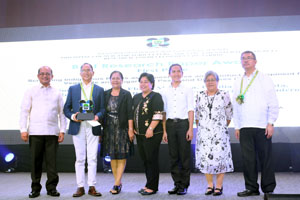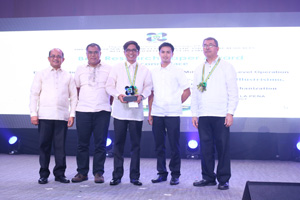
A study on the use of indigenous plants as biopesticides for vegetable diseases was recognized recently in the National Symposium on Agriculture, Aquatic and Natural Resources Research and Development (NSAARRD).
The study titled, “Screening indigenous plants as biopesticides and product development for vegetable diseases” received 1st place with a cash prize of ₱150,000 in the Best R&D Paper Awards, Research Category. The study was implemented by Victor B. Amoroso, Florfe M. Acma, Cecilia V. Bautista, Chris Rey M. Lituanas, Rainear A. Mendez, Iris R. Pescadero, and Annabelle P. Villalobos.
Under the said project, the researchers from the Central Mindanao University identified natural sources of pesticides from plants with pesticide properties and validated their efficacy, specificity, friendliness to the environment, safety to humans and cost efficiency. From the mountains of Mindanao, ten species of plants with potential biopesticide properties against diseases of economically important crops were identified. It was also in this study where Tasmania piperita was identified as the plant with the highest potential as natural fungicide against leaf spot of lettuce (Alternaria brassicae) and late blight of tomato (Phytophthora infestans).
Read more about this project: http://www.pcaarrd.dost.gov.ph/home/portal/index.php/quick-information-dispatch/3224-indigenous-plants-screened-as-biopesticides

Meanwhile, the project, “Design, Testing and Evaluation of Mobile Corn Mill for Village-Level Operation,” won 2nd place with a cash prize of ₱125,000 in the Best R&D Paper, Research Category.
The project was implemented by Dr. Michael A. Gragasin, Dr. Irwin V. Salapare, Engr. Jayvee P. Ilustrisimo and Dr. Romualdo C. Martinez.
Developed by the Philippine Center for Postharvest Development and Mechanization (PhilMech) of the Department of Agriculture (DA), the improved mobile corn mill is considered technically viable and financially feasible.
The technology is a departure from the traditional corn mills that still use emery stone, two steel rollers, and oscillating sifter that all require huge amount of power. It is suitable for both white corn and yellow corn varieties.
Once widely adopted, the developed mobile corn mill technology, with all its advantages, is expected to help in reducing the price of corn grits in the market. As a result, it could induce wider consumption of corn grits and lower the per capita consumption of rice in the country.
Read more about this project: http://www.pcaarrd.dost.gov.ph/home/portal/index.php/quick-information-dispatch/3223-corn-milling-made-easier-with-improved-technology
Organized by DOST-PCAARRD, the NSAARRD recognizes the outstanding contributions of individuals and institutions in improving the state of R&D in the country for the interest of the agriculture, aquatic and natural resources sector.
Held at the Philippine International Convention Center, the NSAARRD’s recognition and awarding ceremonies, as a yearly activity, highlighted the 7th Year Anniversary Celebration of the Philippine Council for Agriculture, Aquatic and Natural Resources Research and Development of the Department of Science and Technology (DOST-PCAARRD).
